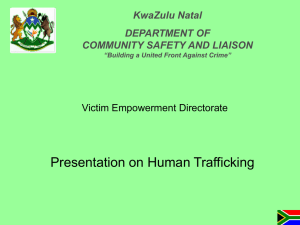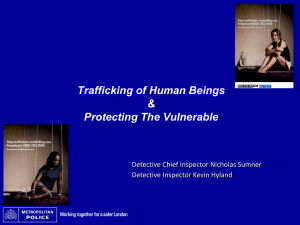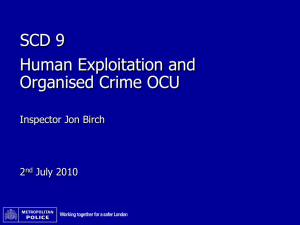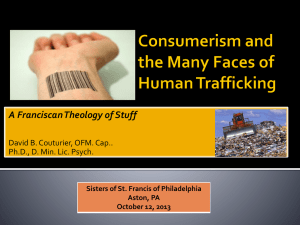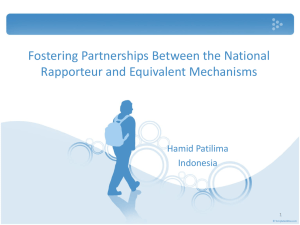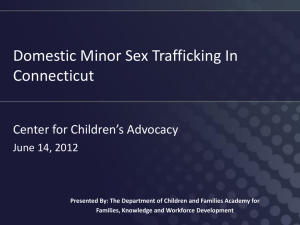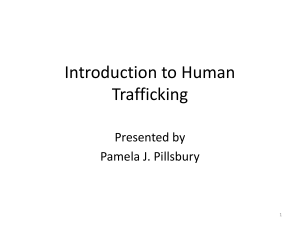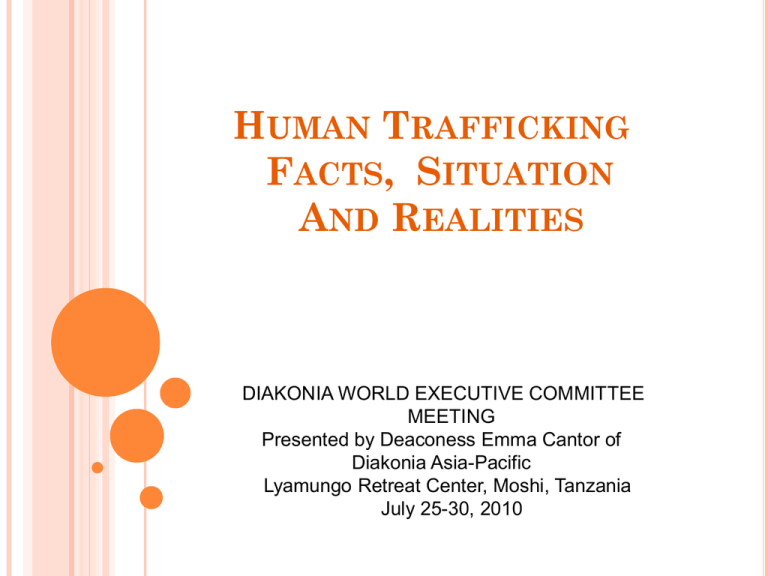
HUMAN TRAFFICKING
FACTS, SITUATION
AND REALITIES
DIAKONIA WORLD EXECUTIVE COMMITTEE
MEETING
Presented by Deaconess Emma Cantor of
Diakonia Asia-Pacific
Lyamungo Retreat Center, Moshi, Tanzania
July 25-30, 2010
The Different Faces and
Realities of Human
Trafficking
Hundred and thousands of these young girls are enslaved by the new
crime of the century called Human Trafficking
Young girls are forced to sell sex by
knocking at a car doors and truck
stations.
Pimps use violence and coercion to commercially
exploit young girls and children
Individuals are forced to prostitute in the hotels
and streets to meet their nightly quotas and turn
the money to their own traffickers to pay
exorbitant money dubbed as loan to them.
Individuals may be forced to work in a highly
exploitative conditions with little pay or no pay at
all. The traffickers and cohorts sucked all that
has to be given to the laborers themselves as fees.
Forms of forced labor have been found in
numerous places including the first world
countries as this case in a restaurant
WHAT IS HUMAN TRAFFICKING?
Article 3, paragraph (a) of the Protocol to Prevent, Suppress
and Punish Trafficking in Persons defines Trafficking in Persons
the act (what is being done):
recruitment, transportation, transfer, harbouring or receipt
of persons,
How is it being done (the means)
threat, use of force, coercion, abduction, fraud, of
deception, abuse of power, or a position of vulnerability o
or of the giving or receiving of payments or benefits
To achieve the:
consent of a person having control over another
person,
The purpose (why is it being done?)
Exploitation.
Exploitation include: at a minimum, the exploitation of the
prostitution of human beings and other forms of sexual
exploitation, forced labour or services, slavery or practices
similar to slavery, servitude or the removal of organs.
Victims are trafficked both within and across
international borders. Migrants as well as internally
displaced persons are particularly vulnerable, as
evidenced by the aftermath of the earthquake in
Haiti.
Hard Facts is that examples of human trafficking
cases span sex trafficking in India and Latin America,
the shrimp industry in Thailand, child soldiers in
Burma, cotton in Uzbekistan, fishing on Lake Volta in
Ghana, and forced labor in Florida’s citrus fields and
Californias’ farms.
Human trafficking affects every country
around the world, regardless of socioeconomic status, history, or political
structure.
Human traffickers have created an
international market for the trade in human
beings based on high profits and demand for
commercial sex and cheap labor.
Sex trafficking occurs when people are forced or coerced
into the commercial sex trade against their will. Child sex
trafficking includes any child involved in commercial sex.
Sex traffickers frequently target vulnerable people with
histories of abuse and then use violence, threats, lies,
false promises, debt bondage, or other forms of control
and manipulation keep victims involved in the sex
industry.
Sex trafficking exists within the broader commercial sex
trade, often at much larger rates than most people realize
or understand. Sex trafficking has been found in a wide
variety of venues of the overall sex industry, including
residential brothels, hostess clubs, online escort services,
brothels disguised as massage parlors, strip clubs,
and street prostitution.
THE HARDER FACTS:
An estimated 12.5 million people are in forced
labour (including sexual exploitation) at any
given time as a result of trafficking
Of these:
1.4 million – 56% - are in Asia and the Pacific
250,000 – 10% - are in Latin America and the
Caribbean
230,000 – 9.2% - are in the Middle East and
Northern Africa
130,000 – 5.2% - are in sub-Saharan countries
270,000 – 10.8% - are in industrialized countries
200,000 – 8% - are in countries in transition
161 countries are reported to be affected by
human trafficking by being a source, transit
or destination count;
People are reported to be trafficked from 127
countries to be exploited in 137 countries,
affecting every continent and every type of
economy;
THE VICTIMS BASED ON RESEARCH
The majority of trafficking victims are between 18 and 24
years of age
An estimated 1.2 million children are trafficked each year.
It is estimated that there are 100,000 children in the sex
trade in the US.
95% of victims experienced physical or sexual violence
during trafficking (based on data from selected European
countries)
43% of victims are used for forced commercial sexual
exploitation, of whom 98 per cent are women and girls
32% of victims are used for forced economic exploitation, of
whom 56 per cent are women and girls
Many trafficking victims have at least middle-level
education
THE PROFITS: A US$32 B INDUSTRY
Estimated global annual profits made from the
exploitation of all trafficked forced labour are
US$ 32 billion
Of these:
US$ 15.5 billion – 49% - is generated in industrialized
economies
US$ 9.7 billion – 30.6% is generated in Asia and the
Pacific
US$ 1.3 billion – 4.1% is generated in Latin America
and the Caribbean
US$ 1.6 billion – 5% is generated in sub-Saharan
Africa
US$ 1.5 billion – 4.7% is generated in the Middle
East and North Africa
THE TRAFFICKERS
52% of those recruiting victims are men, 42% are
women and 6% are both men and women
In 54% of cases the recruiter was a stranger to
the victim, 46% of cases the recruiter was known
to victim
The majority of suspects involved in the
trafficking process are nationals of the country
where the trafficking process is occurring and can
Anyone who is willing to exploit another human
being is willing to exploit another human being
for profit.
TRAFFICKERS
INCLUDE
THOSE
WHO
RECRUIT,
TRANSPORT, HARBOR, OBTAIN, AND EXPLOIT VICTIMS,
OFTEN USING FORCE, THREATS, LIES, OR OTHER
PHYSICAL AND
PSYCHOLOGICAL METHODS
OF
CONTROL. THEY CAN BE FOREIGN NATIONALS AND U.S.
CITIZENS, MALES AND FEMALES, FAMILY MEMBERS,
INTIMATE
PARTNERS,
ACQUAINTANCES,
AND
STRANGERS.
Based on the analysis of cases the common data are the
following:
Pimps
•Intimate partners/family members
•Gangs and criminal networks
•Brothel and massage parlor owners and managers
•Growers and crewleaders in agriculture
•Labor brokers
•Employers of domestic servants
•Small business owners and managers
•Large factory owners and corporations
Potential Human Trafficking Situations according to a
research on victimized people:(National Human Trafficking Resource
Center)
•Is not free to leave or come and go as he/she wishes
•Is under 18 and is providing commercial sex acts
•Is in the commercial sex industry and has a pimp / manager
•Is unpaid, paid very little, or paid only through tips
•Works excessively long and/or unusual hours
•Is not allowed breaks or suffers under unusual restrictions
at work
•Owes a large debt and is unable to pay it off
•Was recruited through false promises concerning the nature
and conditions of his/her work
•High security measures exist in the work and/or living
locations (e.g. opaque windows, boarded up windows, bars
on windows, barbed wire, security cameras, etc.)
Poor Mental Health or Abnormal Behavior
•Is fearful, anxious, depressed, submissive, tense, or
nervous/paranoid
•Exhibits unusually fearful or anxious behavior after
bringing up law enforcement
•Avoids eye contact
Poor Physical Health
•Lacks health care
•Appears malnourished
•Shows signs of physical and/or sexual abuse, physical
restraint, confinement, or torture
Why Trafficking Exists
Like drugs and arms trafficking, human trafficking is a market-driven
criminal industry that is based on the principles of supply and demand.
Many factors make children and adults vulnerable to human trafficking.
Human trafficking does not exist only because many people who are
vulnerable to exploitation.
This is the Truth, that human trafficking is fueled by a demand for cheap
labor or services, or for commercial sex acts. Human traffickers are those
who victimize others in their desire to profit from the existing demand. To
ultimately solve the problem of human trafficking, it is essential to address
these demand-driven factors, as well as to alter the overall market
incentives of high-profit and low-risk that traffickers currently exploit.
It is for money and power, huge money and more power. It is the mode of
the imperialist world.
WHY DOES HUMAN TRAFFICKING CONTINUE
AND AND WIDESPREAD? (National Human Trafficking Resource Center)
Labor trafficking and sex trafficking of U.S. citizens and foreign
nationals persist and thrive for a number of reasons, including:
•Low Risk: When the community is unaware of this issue, when
government and community institutions are not trained to respond,
when there are ineffective or dormant laws to address the crime,
when safety nets for victims do not exist, and when law enforcement
does not investigate and prosecute the crime, human traffickers
perceive little risk or deterrence to affect their criminal operations.
•High Profits: When individuals are willing to buy commercial sex,
they create a market and make it profitable for traffickers to sexually
exploit children and adults.
•When consumers are willing to buy goods and services from
industries that rely on forced labor, they create a profit incentive for
labor traffickers to maximize revenue with minimal production costs.
PROSECUTIONS
In 2006 there were only 5,808 prosecutions and
3,160 convictions throughout the world
This means that for every 800 people trafficked,
only one person was convicted in 2006
PHILIPPINES
The Situation
Philippines is a source, transit, and destination for human
trafficking.
20,000 – 100,000 Philippine and foreign child victims in the
Philippines
Foreign tourists, particularly other Asians, sexually exploit
women and children
PHILIPPINE CASES
Philippine men, women, and girls were trafficked for labor
and sexual exploitation to Saudi Arabia, Kuwait, the
United Arab Emirates, Qatar, Bahrain, Malaysia, Hong
Kong, Singapore, Japan, South Africa, North America, and
Europe.
The Philippine Government and NGO estimates…
300,000 – 400,000 trafficked women
60,000 – 100, 000 trafficked children
TRANSIT
The Philippines is a transit country for victims
trafficked from China.
Destination
The Philippines is a destination country for a small number
of women who are trafficked from the People’s Republic of
China (P.R.C.), South Korea, Japan, and Russia for sexual
exploitation.
Internal Trafficking
The Philippines has internal trafficking of women and
children from rural areas, particularly the Visayas and
Mindinao, to urban areas, such as Metro Manila and Cebu,
for sexual exploitation or forced labor as domestic workers,
factory workers, or in the drug trade.
THE PHILIPPINE GOVERNMENT
The Philippine Government was placed in Tier 2 in
the 2007 U.S. Department of State’s Trafficking in
Persons Report for not fully complying with the
Trafficking Victims Protection Act’s minimum
standards for the elimination of trafficking but
making significant efforts to do so. There are reports
of immigration and police officers who are complicit in
human trafficking.
The 2003 Anti-Trafficking in Persons Act criminalizes
human trafficking, with penalties up to life in prison.
The law allows private prosecutors, including NGOs,
to file lawsuits against traffickers.
PROSECUTION
17 anti-trafficking prosecutors in the Department
of Justice
72 prosecutors in regional Department of Justice
offices
The Philippine government is currently engaged
in 107 prosecutions for trafficking.
A court in Zamboanga City sentenced a member
of a trafficking syndicate to life imprisonment in
March 2007 for having recruited six victims and
selling them to a brothel in Malaysia.10
CHILD SEX TOURISM
In 2006, five foreign tourists were arrested by
Filipino police for sexually exploiting Filipino
children.
The Philippines continued to assist U.S. law
enforcement authorities in the transfer to U.S.
custody of Americans who sexually exploited
children.
For the Mandate and for the Work of
Justice and Peace
Jesus of Nazareth and his gospel of justice, truth, redemption, equality, unity
and love is calling everyone of us.
For Jesus said, “ I HAVE COME THAT YOU MIGHT HAVE LIFE AND HAVE IT
ABUANDANTLY.”
The Diaconate Prophetic Call is our call for the work of justice and peace. We
name and seek the truth for sake of life.
We are called setting aside our fears, make our ways responsible and help
heal our dying world.
We have a prophetic calling as Christians and believers in Jesus to speak out
as he did without fear or favor to the authorities, religious or perpetuators and
syndicates.
Lord We Pray for Justice and Peace. We pray that you make us
instruments of your peace as members of the Diaconate World.
We pray for:
Bread. Rice. Education. Shelter. Peaceful environment
A clean sky.
Active peace.
A human’s voice singing somewhere
Melody drifting like smoke from the cookfires.
The army disbanded
The harvest abundant
The wound healed,
The child wanted,
The prisoner freed,
The body’s integrity honored,
The love returned,
The labor equal, fair and valued.
Men and women are equally empowered
For equality and equal access to every opportunity. Amen!



